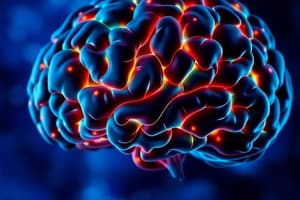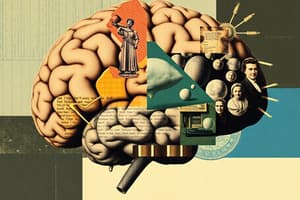Podcast
Questions and Answers
Which of the following brain regions is NOT directly involved in integrating information from different sensory modalities to guide complex behaviors?
Which of the following brain regions is NOT directly involved in integrating information from different sensory modalities to guide complex behaviors?
- Temporal association cortex
- Primary motor cortex (correct)
- Frontal association cortex
- Parietal association cortex
What is the main type of excitatory neuron found in the deep and superficial layers of the neocortex?
What is the main type of excitatory neuron found in the deep and superficial layers of the neocortex?
- Glial cells
- Stellate cells
- Pyramidal cells (correct)
- Interneurons
Damage to the parietal association cortex can lead to which of the following conditions?
Damage to the parietal association cortex can lead to which of the following conditions?
- Visual neglect (correct)
- Aphasia
- Prosopagnosia
- Agnosia
Which of the following brain regions is responsible for spatial attention and perceptual awareness?
Which of the following brain regions is responsible for spatial attention and perceptual awareness?
What is the primary function of the pulvinar and medial dorsal nuclei?
What is the primary function of the pulvinar and medial dorsal nuclei?
What is the main function of the stellate cells in layer 4 of the neocortex?
What is the main function of the stellate cells in layer 4 of the neocortex?
Which of the following is NOT a typical feature of the neocortical connectivity patterns?
Which of the following is NOT a typical feature of the neocortical connectivity patterns?
Which of the following statements is true about the evolution of neocortical structure?
Which of the following statements is true about the evolution of neocortical structure?
What type of cognitive difficulties might arise from damage to the temporal association cortex?
What type of cognitive difficulties might arise from damage to the temporal association cortex?
Which of the following demonstrates the role of the frontal association cortex in planning and decision-making?
Which of the following demonstrates the role of the frontal association cortex in planning and decision-making?
Flashcards
Cognition
Cognition
Mental process of acquiring knowledge through thought, experience, and senses.
Brodmann Areas
Brodmann Areas
Cortical subdivisions based on cytoarchitectural differences.
Pyramidal Cells
Pyramidal Cells
Main type of excitatory neuron in cortical layers, involved in cortical signaling.
Cortical Layers
Cortical Layers
Signup and view all the flashcards
Stellate Cells
Stellate Cells
Signup and view all the flashcards
Parietal Association Cortex
Parietal Association Cortex
Signup and view all the flashcards
Temporal Association Cortex
Temporal Association Cortex
Signup and view all the flashcards
Frontal Association Cortex
Frontal Association Cortex
Signup and view all the flashcards
Attention Modulation
Attention Modulation
Signup and view all the flashcards
Gnostic Neurons
Gnostic Neurons
Signup and view all the flashcards
Study Notes
Cognition and Brain Structure
- Cognition is the mental process of acquiring knowledge and understanding, involving memory, attention, language, problem-solving, and planning.
- Brain regions integrate information from different areas, including emotional processing and cortical regions.
Brodmann's Cortical Subdivisions
- Brodmann categorized early cortical regions based on cytoarchitecture (cellular structure).
- Newer methods now use finer divisions considering lamination, cell density, and connectivity.
Classical Cortical Structure (Mammalian)
- The mammalian neocortex typically shows six layers.
- Pyramidal cells are the main excitatory neuron type in the deep and superficial layers with their dendrites and axons projecting within or outside the cortex.
Cortical Layers
- Layer 1: Composed mainly of axons and interneurons.
- Layers 2 & 3: Contain pyramidal cells whose axons project to other cortical areas or to subcortical regions (white matter).
- Layer 4: Receives sensory input mainly from the thalamus, containing stellate cells.
- Layer 5: Contains large pyramidal cells, receiving inputs from layers 1-4, projecting to subcortical structures (e.g., brainstem and spinal cord).
- Layer 6: Contains small pyramidal neurons, projecting back to the thalamus.
Pyramidal Cell Function
- Pyramidal cells integrate and compare various inputs.
Stellate Cell Function
- Stellate cells have dendrites primarily located in layer 4.
Cortical Lamination Variations
- Variations in layering exist across different brain regions, some having fewer layers (3-4).
Neocortical Connectivity Patterns
- Thalamic input is a crucial pathway, delivering sensory information primarily to layer 4.
- Brainstem activity affects the whole cortex, influencing arousal and cognition.
Association Cortex
- Association cortex receives input from various thalamic nuclei (including pulvinar and medial dorsal nuclei).
- Primary sensory and motor cortices are relatively smaller parts, and receive sensory information via thalamic nuclei.
Parietal Association Cortex
- Involved in spatial attention and perceptual awareness.
- Damage can lead to visual neglect (ignoring one side of the visual field) and apraxia (difficulty with planned movements).
- The right parietal cortex is more dominant for spatial attention, influencing both visual fields. Language processing is more associated with the left parietal cortex.
Attentional Behavior
- Attention enhances activity in specific brain regions, particularly the contralateral visual cortex when processing visual stimuli and related extra striate visual cortices.
- Neurons involved in visual attention exhibit increased firing rates during task execution and with increasing reward.
Temporal Association Cortex
- Damage leads to agnosias (problems with object recognition).
- Recognition of faces, voices, and objects is related to specific areas within the inferior temporal lobe.
- Face recognition features brain activity in identified regions, but a scrambled face elicits less response.
- Gnostic neurons (e.g., "Jennifer Aniston cells") are uniquely responsive to specific complex stimuli like faces or concepts.
Frontal Association Cortex
- The frontal association cortex, located at the front of the brain, integrates complex information from sensory, motor, temporal, and association cortices, contributing to decision-making, planning, personality, working memory, and social behavior.
- Damage can lead to changes in personality, impairment in planning and social behavior, and difficulty with complex cognitive tasks.
- Frontal cortex activation during tasks are present.
- The dorsolateral prefrontal cortex plays a crucial role in tasks requiring planning and working memory. Delayed-response tasks can assess frontal lobe function.
Studying That Suits You
Use AI to generate personalized quizzes and flashcards to suit your learning preferences.




